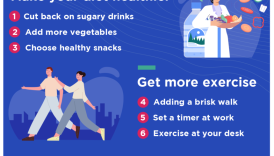Thriving on a Low-Fat Diet: Strategies for Long-Term Success

Importance of a Low-Fat Diet
In a world where the fight against obesity and heart disease is more pressing than ever, many individuals are turning to low-fat diets as a viable solution to achieve their health goals. A low-fat diet isn’t just about reducing fat intake; it encourages a healthier relationship with food, emphasizing whole grains, fruits, vegetables, and lean proteins. Imagine going to the grocery store and confidently choosing items that contribute positively to your overall well-being rather than feeling overwhelmed by unhealthy options. Knowing which foods fit into a low-fat diet can empower anyone on their journey toward better health. This dietary approach not only supports weight management but also helps in lowering cholesterol levels and reducing the risk of chronic diseases.
- Thriving on a Low-Fat Diet: Strategies for Long-Term Success
- Importance of a Low-Fat Diet
- Key Benefits of Long-Term Success
- Understanding Low-Fat Diets
- What Constitutes a Low-Fat Diet
- Potential Health Impacts
- Planning Your Low-Fat Meals
- Choosing the Right Foods
- Meal Prep Tips for Success
- Incorporating Exercise Into Your Routine
- Benefits of Exercise on a Low-Fat Diet
- Best Exercises for Success
- Monitoring Progress and Adjusting
- Tracking Food Intake and Fat Intake
- Making Necessary Adjustments for Long-Term Success
Key Benefits of Long-Term Success
The advantages of committing to a low-fat diet extend beyond the initial weight loss. Here are some key benefits that many people experience over time:
- Sustained Weight Management: A balanced low-fat diet can help maintain weight after the initial loss, providing a stable foundation for long-term health.
- Improved Heart Health: Reducing fat, especially saturated and trans fats, is linked to lower cholesterol levels and a reduced risk of heart disease.
- Enhanced Energy Levels: With a focus on nutrient-rich foods, individuals often report increased energy, making it easier to engage in daily activities and exercise.
- Better Digestive Health: Incorporating fiber-rich foods that are low in fat promotes healthy digestion and can prevent issues like constipation.
For instance, a friend of mine decided to transition to a low-fat diet after feeling lethargic and unhealthy for years. The changes didn’t happen overnight, but over time, they noticed a significant surge in their energy levels and a newfound enthusiasm for physical activities. Not only did they shed unwanted pounds, but they also felt a sense of accomplishment and motivation that turned into a lifestyle change. By embracing the principles of a low-fat diet, individuals can pave the way for improved health, enhanced well-being, and a happier life. The benefits are profound, proving that what you choose to eat today can impact your tomorrow.
Understanding Low-Fat Diets
What Constitutes a Low-Fat Diet
A low-fat diet primarily focuses on reducing total fat intake, allowing individuals to better manage their weight and overall health. But what exactly does “low-fat” mean? Generally, a diet that contains less than 30% of total daily calories from fat is classified as low-fat. Within this framework, here are some key food components:
- Lean Proteins: Skinless poultry, fish, beans, and legumes provide essential nutrients without excessive fat.
- Whole Grains: Foods like brown rice, quinoa, and whole-grain bread are not only low in fat but also high in fiber, promoting satiety.
- Fruits and Vegetables: Naturally low in fat, these foods are rich in vitamins, minerals, and antioxidants, making them ideal for any diet.
- Low-Fat Dairy Products: Choosing low-fat or fat-free options for milk, yogurt, and cheese contributes to reduced fat intake without sacrificing taste.
An example of this might be a typical lunch: a salad topped with grilled chicken breast, colorful veggies, and a light vinaigrette dressing. By making conscious choices about what is placed on the plate, individuals can adhere to a low-fat lifestyle more easily.
Potential Health Impacts
The impacts of a low-fat diet can be significant, especially when followed consistently. Not only can it lead to weight loss, but it also promotes various positive health effects:
- Reduced Risk of Chronic Diseases: Studies have shown that maintaining a low-fat diet can lower the risk of heart disease, high blood pressure, and certain cancers.
- Enhanced Nutritional Profile: By focusing on whole, unprocessed foods, individuals often experience an increase in essential nutrients, such as vitamins C, E, and various B vitamins.
- Improved Blood Sugar Control: A low-fat approach can aid in better glycemic control, which is particularly beneficial for those at risk for diabetes.
Take my neighbor, for instance. After adopting a low-fat diet, they discovered not only was their waistline shrinking, but their doctor’s visits became less frequent. Heart-related concerns that once loomed large slowly faded into the background, allowing them to enjoy life more. Understanding the fundamentals of a low-fat diet can set the stage for healthier eating habits and better lifestyle choices. It’s about making informed decisions that contribute to long-lasting, positive health impacts.
Planning Your Low-Fat Meals
Choosing the Right Foods
Once you understand the basics of a low-fat diet, the next step is to carefully choose the foods that will fill your plate. Selecting the right ingredients not only makes meal preparation easier but also ensures that you’re nourishing your body effectively. Here are some essentials to consider:
- Fruits and Vegetables: Aim for a colorful variety. Not only are they low in calories and fat, but they’re also packed with important vitamins and minerals. Think berries, leafy greens, and vibrant bell peppers.
- Lean Proteins: Grilled chicken, turkey, fish, beans, and legumes are excellent choices. Incorporating these can help you feel satisfied without the added fat.
- Whole Grains: Swap out white bread and pasta for options like quinoa, brown rice, and whole-wheat bread. These provide fiber, which is crucial for digestion and can help you feel full longer.
- Healthy Fats: While the term is “low-fat,” not all fats are created equal. Incorporating small amounts of healthy fats from sources like avocados, nuts, and olive oil can enhance flavor and nutritional value.
For example, imagine preparing a low-fat stir-fry using a medley of vegetables, lean chicken, and a splash of soy sauce. It’s not only delicious but also aligns perfectly with your dietary goals!
Meal Prep Tips for Success
Effective meal prepping can be a game-changer in maintaining a low-fat diet. By planning ahead, you reduce the likelihood of reaching for unhealthy snacks when hunger strikes. Here’s how to optimize your meal prep:
- Plan Your Meals: Dedicate some time each week to plan your meals. Having a structured plan helps in making grocery lists and avoiding impulse buys.
- Batch Cook: Cooking in larger quantities allows you to prepare meals ahead of time. Consider making a big pot of vegetable soup or a hearty stew that lasts a few days.
- Portion Control: Use portion control containers or clear glass jars to store prepped meals. This helps in managing calorie intake while also making meals easy to grab on busy days.
- Keep Snacks Handy: Prepare healthy snacks like cut-up veggies, hummus, or low-fat yogurt. Having these accessible can keep you from indulging in higher-fat, less nutritious options.
A close friend of mine embraced meal prepping and noticed how it transformed their eating habits. They would spend a few hours on the weekend preparing lunches and dinners that were light yet satisfying. Not only did this save time during the week, but it also kept their cravings in check. By carefully choosing the right foods and implementing effective meal prep strategies, individuals can seamlessly integrate a low-fat diet into their daily routine. This structured approach lays the foundation for long-term dietary success.
Incorporating Exercise Into Your Routine
Benefits of Exercise on a Low-Fat Diet
Integrating exercise into your daily routine can significantly enhance the effectiveness of a low-fat diet. While dietary changes are essential for weight management and overall health, physical activity complements those changes by fostering a more active lifestyle. Here are several key benefits of combining exercise with a low-fat diet:
- Increased Caloric Burn: Regular exercise boosts the number of calories burned, helping create a caloric deficit, which is vital for weight loss.
- Improved Muscle Tone: While losing weight, incorporating strength training can help preserve lean muscle mass, leading to a more toned appearance.
- Better Mood and Motivation: Exercise releases endorphins, the body’s natural feel-good hormones, which can elevate your mood and keep you motivated on your dietary journey.
- Enhanced Lifestyle Changes: Physical activity encourages you to make healthier choices beyond just diet, such as opting for stairs instead of elevators or walking instead of driving.
A friend who paired their low-fat diet with regular workouts found that it not only helped them shed pounds but also lifted their spirits. They discovered new hobbies, like running and group classes, which not only provided a sense of community but also made staying active genuinely enjoyable.
Best Exercises for Success
Finding enjoyable exercises is key to maintaining consistency. Here are some great options that work well alongside a low-fat diet:
- Cardiovascular Training: Activities like walking, jogging, cycling, or swimming are fantastic for burning calories. Aim for at least 150 minutes of moderate aerobic activity a week.
- Strength Training: Incorporate two days a week of strength exercises focusing on major muscle groups. This may include body-weight exercises (like push-ups and squats) or weight lifting, which helps build muscle and boost metabolism.
- Flexibility and Balance: Don’t overlook yoga or Pilates. These options enhance flexibility, reduce injury risk, and can complement your cardiovascular and strength routines.
- Group Classes or Sports: Engaging in group fitness classes or team sports can make exercising social and fun, motivating you to stay committed.
When my neighbor decided to join a local Zumba class while transitioning to a low-fat diet, the experience transformed their routine. They connected with others pursuing similar goals and found that the fun atmosphere made exercising feel less like a chore and more like a lifestyle change. By recognizing the synergy between exercise and a low-fat diet, individuals can maximize their health potential, cultivate enjoyable fitness habits, and foster a more fulfilling lifestyle. This holistic approach is crucial for achieving long-term success in weight management and overall well-being.
Monitoring Progress and Adjusting
Tracking Food Intake and Fat Intake
As individuals dive deeper into their low-fat diet journey, tracking progress becomes a vital component of achieving long-term success. Knowing what, when, and how much to eat can provide critical insights that influence dietary choices. Start by consistently logging food intake. This can be done using a simple notebook, mobile app, or even spreadsheets. Here are essential elements to monitor:
- Daily Caloric Intake: Keep track of total calories consumed each day to ensure it aligns with your weight loss or maintenance goals.
- Fat Grams: Pay particular attention to the amount of fat you’re consuming. Aim for less than 30% of total daily calories from fat, and prioritize healthy fats when possible.
- Nutrient Balance: Besides tracking fats, logging overall nutrient intake can help ensure that you’re getting enough proteins, carbohydrates, vitamins, and minerals.
For example, after tracking her meals for a few weeks, my colleague realized she was consuming more hidden fats from snacks than she thought. By adjusting her snack choices to include fresh fruit or low-fat yogurt, she was able to cut back on excess calories without feeling deprived.
Making Necessary Adjustments for Long-Term Success
Tracking progress is just one aspect; making adjustments is equally crucial. Here are practical tips for adapting your diet and lifestyle based on your tracking results:
- Assess Your Goals: Regularly review your progress to determine if you’re meeting your goals. If weight loss has stalled or you’re feeling sluggish, it might be time to reassess your strategy.
- Adjust Caloric Intake: If you’ve lost weight but find you’re plateauing, consider adjusting your daily caloric intake or increasing physical activity for further fat loss.
- Experiment with New Recipes: Trying new low-fat recipes can keep your meals exciting. Exploring seasonal fruits and vegetables can introduce variety and prevent boredom.
- Listen to Your Body: It’s essential to listen to how your body responds. If you feel fatigued, take a step back and evaluate your nutrient intake and exercise routine.
A close friend of mine faced challenges as her weight loss plateaued. Instead of giving up, she decided to reassess her meals and ramp up her physical activity by incorporating more strength training. This evaluation not only reignited her weight loss journey but also brought in newfound energy and enthusiasm. Monitoring food and fat intake, while making necessary adjustments, creates a dynamic approach to achieving and sustaining goals. This proactive mindset instills confidence, leading individuals to embrace their low-fat journey more effectively over time.



